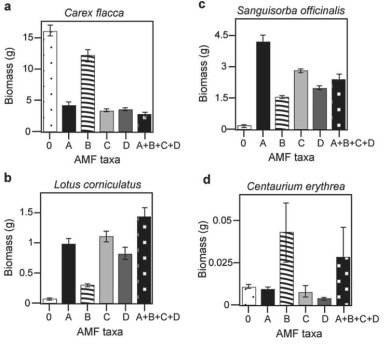Figure 31.4
Use the following information when answering the corresponding question(s) .
There is much discussion in the media about protecting biodiversity,but does it really matter? Canadian and Swiss researchers wanted to know if the diversity of arbuscular mycorrhizal fungi (AMF) was important to the productivity of grasslands (M.G.A.van der Heijden,J.N.Klironomos,M.Ursic,P.Moutoglis,R.Streitwolf-Engel,T.Boler,A.Wiemken,and I.R.Sanders.1998.Mycorrhizal fungal diversity determines plant biodiversity,ecosystem variability and productivity.Nature 396:69-72) .Specifically,they wanted to know if it mattered which specific AMF species were present,or just that some type of AMF was present.They grew various plants in combination with one of four AMF species,no AMF,or all four AMF species together;and they measured plant growth under each set of conditions.All plant species were grown in each plot,so they always competed with each other with the only difference being which AMF species were present.Use the graphs in Figure 31.4 to answer the questions that follow.Note that the x-axis labels indicate the number and identity of AMF species (bar 0 = no fungi;bars A-D = individual AMF species;bar A+B+C+D = all AMF species together) .The y-axis indicates the amount (grams) of plant biomass for the species shown in italics above each graph.

-Based on the van der Heijden et al.(1998) graphs in Figure 31.4,which of the following is the best description of the data supporting the idea that a plant species did not form mycorrhizae with a fungus?
Definitions:
Contributing Member
A contributing member refers to an individual who actively participates and adds value within a team or organizational context.
Appointed Head
A leader or executive placed in their position by a higher authority rather than through election or self-assertion.
Mentor Or Sponsor
A relationship in which an experienced individual (mentor or sponsor) provides guidance, advice, and support to a less experienced person to help them progress in their career or personal development.
Developmental Groups
Groups focused on the growth and development of their members, often through shared learning experiences, skill-building activities, or supportive interactions.
Q4: While examining soil from a cornfield,you found
Q5: Which of these mollusk features substitutes for
Q8: If a particular species of bacterium were
Q9: A gardener in Canada wants to surprise
Q10: Applying the principle of parsimony to the
Q14: You find a fruit that has little
Q15: The figure above shows the distribution of
Q18: If a scientist wanted to prevent a
Q38: What is the function of the osmotic
Q65: Refer to the paragraph on the research